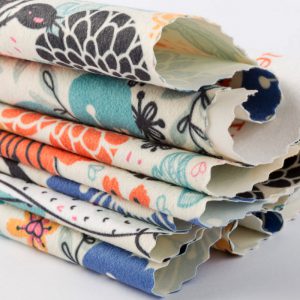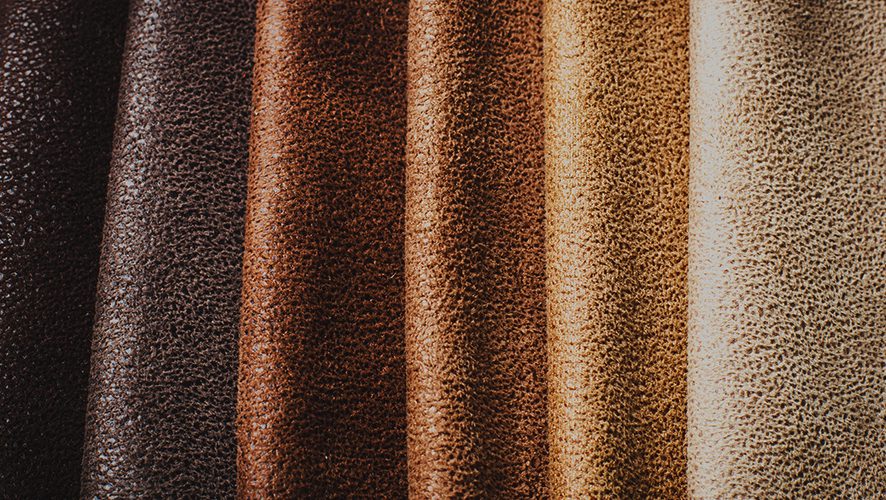As a fashion lover, a textile designer or an avid shopper, you’ve probably come across the term ‘suede’ in various shops or fashion magazines. But what is suede exactly, and why do we use it? In a nutshell, suede is a particular finish of leather (often referred to as suede leather). Rather than being a different variety of the material, Suede simply refers to the finish that gives the fabric a soft, fibrous effect.
1. How is Suede made?

Suede is the inner surface of animal hides, visible on the underside of leather. Leather is a material created by processing the hides, pelts and skins of animals in a range of ways. Occasionally manufacturers or designers will use this soft underside of the leather simply by turning the material upside down so the suede is on the exterior. However, this results in the material being much sturdier and can take away from the lovely delicate quality of suede which it is known for.
The majority of the time a more popular method is used where the leather is split and the upper grain is removed to reveal only the fuzzy, napped underside which then becomes visible on both sides of the fabric. This second technique of creating suede results in a much softer and pliable leather.
2. What is Suede made of?

So, what is suede made of? Amazingly suede leather can be made from almost any animal hide, but the most common is lamb, alongside goat, deer, pig and calf. The type of animal has an effect on the finish of the suede; when using thicker hides of older cows and deer, the nature of the fiber results in the suede having a much shaggier ‘nap’ which isn’t as soft as the lighter suede we’re accustomed to. The ‘nap’ of the fabric is the raised surface on the texture; a result of the way the tiny hairs lie across the top of the material.
3. What is it used for?
Not being particularly durable and unsuitable for upholstery or outerwear, you might find yourself asking, what is suede actually used for? The beautifully soft and light nature of suede makes it perfect for clothing and high-quality fashion accessories, including bags, shoes and more, as well as being a lining for sturdier leather items. One of the most popular uses for suede is traditional Western leather jackets. Have you seen that fringing!? Oh, and not to mention Elvis’s blue suede shoes of course.
4. What are the origins of Suede?
Amazingly, animal hides have been used to create clothing and household items from as far back as the Paleolithic era, so leather has a long and cultured history. A dramatic change came about during the Industrial Revolution, where new kinds of tanning chemicals were available which were vital to the creation of leather.
During the 20th century, Suede became much more popular in the fashion industry and was considered a symbol of status, due to its delicate and luxurious nature. Suede is incredibly versatile – the fluid characteristic of the fabric meant it became a favourite for high fashion designers such as Paquin, Givenchy and Hermes for the catwalks. In fact, even to this day designers work with tanneries to create totally unique leather for their collections.
The term ‘suede’ actually originates from France, where the phrase ‘gants de Suede’ – roughly translating to ‘gloves from Sweden’ – was used to refer to a specific type of very soft gloves which were imported from Sweden. Eventually the phrase began to refer to any type of leather based material with a napped finish.
5. Genuine Vs. Faux – What’s the Difference?

Incredibly many people actually prefer faux suede to the real deal. Faux suede – or ‘suedette’ – offers a range of benefits over opting for real leather. This animal-friendly alternative maintains the appearance and texture of suede down to the soft, brushed surface without the disadvantage of fraying or potential matting. It’s also much easier to clean; genuine suede is sensitive to water, but faux suede is usually created with a water repellent quality so it can be safely and easily cleaned. If that wasn’t enough, the tightly woven nature of faux suede means it repels stains easily – so you won’t even need to wash it as often. Did I mention it’s also significantly cheaper?
6. Types of Suede Leather
There are a huge range of leathers and various types of suede leather available which is dependent on the type of animal hide used.
Sheepskin Suede
Predominantly made from the skins of lambs (they’re lighter and softer than their older counterparts), this pliable, brush textured suede with a velvet nap is the most lightweight and delicate type of suede widely available. Although as mentioned suede is not waterproof, sheepskin suedes are excellent at keeping out that cold wind and damp during the Winter months.
Pigskin Suede
Pigskin is not quite as popular as sheepskin, being much tougher and firmer in texture. It can still be used to create suede but with a much shorter soft nap on the surface, and is typically longer lasting than other suedes.
Cowhide Suede
Just like sheepskin, calves produce much softer hides than fully grown cows. Creating a suede with a coarser nap, it’s not as popular as the previous options but can create a very durable leather if you’re after something incredibly long-lasting.
7. What are the Advantages and Disadvantages?

With any fabric there are advantages and disadvantages; here are suede’s most noteworthy qualities:
Advantages
- Thicker suede can be durable
- Soft and luxurious feeling
- Brushed face
- Long lasting
Disadvantages
- Absorbs water easily
- Can become dirty quickly
- Not overly resilient
- Expensive
8. Can you Print on Suede?
So, now that you’ve got an answer to the question ‘what is suede?’ Why not try designing your own faux suede fabric? It really is much simpler than you might think. Just upload your favourite image or pattern or even a photo into our design interface, repeat your image, select your dimensions, done. You can order a test print first and not only will you get to see for yourself how simple it is, but you’ll also receive a voucher for a discount on your first fabric order.
Explore faux suede and over 100 other fabrics in your own swatch pack.



Thank you. Very informative!
I need fake suede leather compotion.(ex. 98%cotton 2% elastic)
I need fake suede leather compotion.(exampl…. 98%cotton 2% elastic)
Fantastic facts! Thanks for sharing 🙂